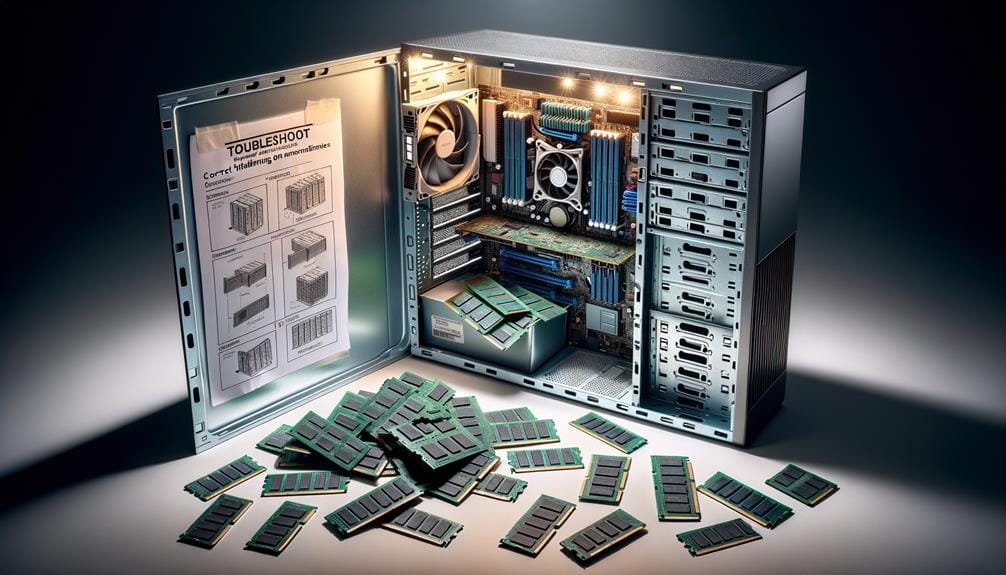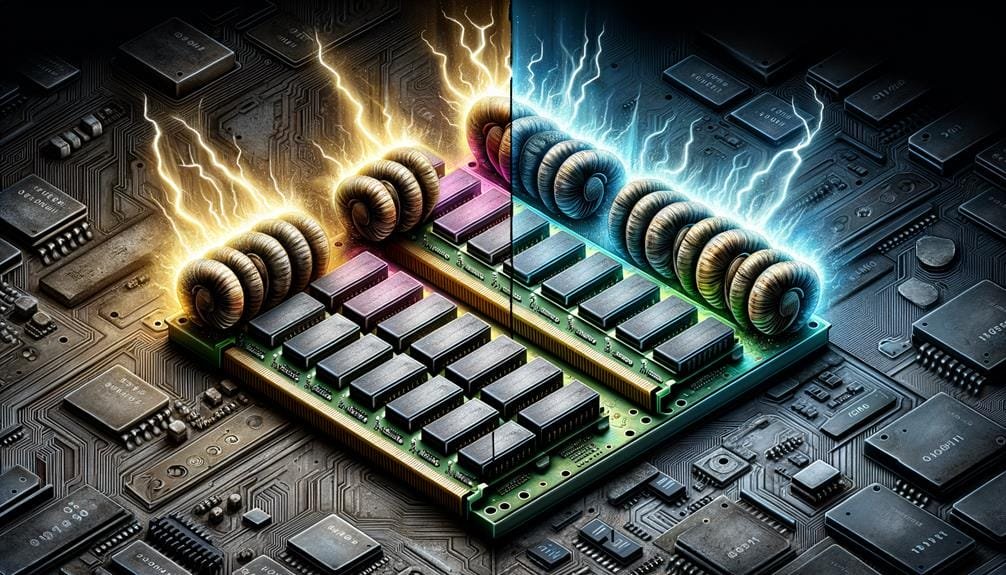Our Newsletter
Sign up for our e-mail newsletter and stay informed for what’s next on the horizon.
Doesn’t it just grind your gears when your computer starts to lag or halt right when you’re tackling a crucial project? We’ve all faced this situation, and it’s usually a definite signal that your computer’s memory, or RAM, might be in need of an upgrade.
But how can you be certain, and what actions are required? We’re here to walk you through the procedure. From evaluating your computer’s existing capacity to choosing and installing the correct memory upgrade, there’s a lot to take in.
Keep reading as we explain the complexities and potential benefits of upgrading your computer memory.
In conclusion, we’ve journeyed through the complex labyrinth of memory upgrades together, uncovering its concealed features. Upgrading your computer’s memory isn’t just a technical task, but an investment in efficient, seamless computing.
We’ve highlighted the signs, examined the options, and offered a guide for installation. Remember, avoiding upgrade errors and optimizing memory usage are vital steps in this journey.
So, let’s embrace the power of enhanced memory and rise to new heights of computing prowess.
Venturing into the world of computer memory, or RAM, it’s noteworthy that this part is a workhorse storing data that’s actively accessed by the CPU, playing a critical role in ensuring fast access to information required to operate programs and applications. This form of memory is transient, which means that all data disappears once we switch off the computer.
Insufficient RAM can lead to slow performance, restricting our ability to fully utilize our computers. For gaming enthusiasts, this could signify the gap between a smooth, engaging experience and an annoying, delay-riddled session. In the same way, for those of us who juggle demanding applications, insufficient RAM can significantly reduce efficiency.
Let’s look into the indicators of insufficient memory, such as sluggish performance, regular system breakdowns, and hang-ups. These problems can profoundly disrupt a computer’s functionality, leading to reduced efficiency and output.
We’ll also touch on the advantages of improving memory as opposed to continually coping with system hang-ups and other performance issues.
Identifying the indicators of low memory is key, as symptoms such as system crashes, freezing, and an obvious slowdown during multitasking may suggest that your computer is low on memory. A typical symptom of low memory is when your computer’s functionality begins to slow down, particularly when you’re operating multiple applications or gaming. You might experience lengthy load times or even game crashes, which can drastically impact your gaming capabilities.
Other symptoms encompass applications shutting down unexpectedly or not loading, and lags in file storage and data computing. These symptoms suggest that your computer’s RAM is inadequate for your usage, hinting that a memory upgrade could be beneficial.
Keep in mind, boosting your memory can greatly enhance your computer’s functionality.
A lack of sufficient computer memory can hinder optimal performance, leading to regular system freezes, software crashes, and an overall delayed system response when managing multiple applications at once. These symptoms suggest that your computer lacks sufficient RAM, making it challenging to multitask and operate resource-demanding applications.
Memory isn’t just a storage area; it serves as the workspace where your computer processes data. Therefore, the more memory your computer has, the greater amount of data it can handle at once, improving its performance. Upgrading your computer’s memory can provide a notable improvement, particularly when utilizing resource-intensive software like video editing tools or video games.
Simply put, if you want to multitask effectively, consider increasing your computer’s memory. It’s a smart decision for a smoother, faster, and more dependable performance.
Experiencing regular freezing or system crashes is a clear sign that your computer’s RAM (Random Access Memory) is at its maximum. We can deduce these are indications of not enough memory, especially when we’re operating several applications simultaneously. Upgrading your computer’s memory can mitigate these problems and improve system steadiness.
To simplify, let’s split the advantages of a memory upgrade into three sections:
What is the current and maximum capacity of your computer’s memory, and how much does it need for optimum functioning? It is vital to inspect your computer’s RAM and memory capacity. This can be accomplished by accessing the system settings or consulting your manufacturer’s details. Being aware of the highest quantity of RAM your computer can support is fundamental for better multitasking and enhanced computer performance.
Following, we’ll inspect your current memory utilization. This will aid us in determining if you need to increase your RAM. Generally, we check if your system is often exhausting its memory, particularly when operating resource-intensive applications.
The nature of applications you operate significantly influences your memory requirements. Some applications demand more memory for effective functioning. Boosting your computer’s memory can result in swifter performance and improved productivity.
| RAM | Current & Maximum |
| Memory Usage | Inspection |
| Application Types | Effect on Memory |
| Performance | Advancement by Upgrading |
| Productivity | Boost by Upgrading |

After evaluating your computer’s memory capacity and requirements, the vital proceeding step is opting for the suitable memory upgrade, considering the compatibility with your motherboard’s highest capacity and speed. This necessitates an understanding of your RAM, memory slots, and memory modules.
Let’s focus on three main aspects:
Opting for the right memory upgrade isn’t just about increasing capacity; it’s about improving your system’s performance and your overall user experience. By adequately understanding your system’s needs and restrictions, you can pick the optimal memory modules for your upgrade, ensuring you maintain the performance flexibility you require.
Let’s undertake the process of setting up your new memory.
We’ll initiate by detailing how to ready your computer for the installation procedure, guaranteeing safety and preventing possible harm.
Next, we’ll guide you step by step through the exact process of memory installation, from eliminating the old modules to confirming the successful identification of your new memory.
Prior to commencing the memory upgrade, we need to make sure we’ve all the required tools ready, such as a Crucial® desktop memory kit and a screwdriver, and correctly switch off the desktop computer to ward off any possible damage.
After setting up the desktop computer and removing the existing memory modules, we’re ready to install the new RAM, a vital part of enhancing the computer’s performance capabilities.
It’s mandatory to switch off and disconnect the computer before starting the memory installation process. We need to ground ourselves to avoid static discharge, which could potentially harm the memory module.
We must find the motherboard slots, ensuring the notches on the memory module line up with the slots for correct installation. While applying uniform pressure, we push the memory module into position until the clips secure it.
Following this, we reconstruct, reconnect all cables, and turn on the computer to confirm our successful upgrade.

To avoid getting ensnared in memory upgrade errors, checking our motherboard’s maximum memory capacity beforehand is a necessary step. Going beyond our motherboard’s limit during an upgrade can result in compatibility problems, potentially affecting system functionality. Therefore, it’s essential to not exceed our motherboard’s memory capacity during the upgrade.
Additionally, we’ve to ensure that the memory modules we purchase coincide with the speed and type that our motherboard supports. It’s not just about capacity; speed is a pivotal factor in our computer’s performance. The incorrect speed could lead to performance problems, slow our system down, or worse, lead to system instability.
Finally, correct placement of the memory modules is essential. We need to ensure the modules are correctly positioned in the slots on the motherboard. A module that hasn’t been properly placed mightn’t be recognized, and forcing a module into place can lead to damage to delicate components.
In summary:
Since we’ve discussed preventing errors during a memory upgrade, let’s shift our focus to optimizing memory usage in our computer system. To get the most out of your PC’s performance, it’s vital to fully comprehend RAM.
You can monitor memory usage and shut down unneeded applications using the Task Manager. This action liberates RAM, making your system operate more smoothly. Moreover, turning off memory-intensive startup programs can improve your startup speed.
Routine upkeep is also important. Deleting temporary files and cache not only creates more disk space but also minimizes memory clutter, enhancing efficiency. It’s vital to keep your operating system and software up-to-date to ensure they work well with different types of RAM.
Consider switching to a solid-state drive for superior performance.
Here is a useful table summarizing our main points:
| Action | Benefit | Tool |
|---|---|---|
| Shut down unneeded apps | Liberates RAM | Task Manager |
| Turn off startup programs | Improved startup speed | System settings |
| Delete temp files and cache | Minimizes memory clutter | Disk cleanup tool |

Let’s examine the many benefits of augmenting your computer’s memory, which primarily encompass improved system function, amplified multitasking abilities, and a more fluid gaming experience.
When you augment your computer’s RAM (Random Access Memory), you’re fundamentally providing more space for your system to operate, consequently improving system function. This results in quicker data retrieval and processing, making your computer more efficient.
In terms of multitasking, it’s effortless with a memory augmentation. More memory implies your computer can manage numerous tasks at once without deceleration or freezing. This is crucial if you’re a person who appreciates the liberty of operating several applications or tabs concurrently.
Now let’s touch on the gaming experience. Augmented memory leads to faster loading times and more fluid gameplay, which is a necessity for any serious gamer.
Here are three key benefits:
Ultimately, we’ve traversed the maze of memory upgrades jointly, revealing its hidden aspects. Improving your computer’s memory isn’t merely a technical chore, but an investment in smooth, effective computing.
We’ve spotlighted the indicators, scrutinized the alternatives, and provided an assembly guide. Bear in mind, evading upgrade blunders and maximizing memory utilization are crucial stages in this process.
So, let’s welcome the strength of improved memory, and ascend to new peaks of computing capability.
“We improve our computer memory to boost multitasking, accelerate processing, and operate heavy-duty applications effortlessly. It’s crucial for effectiveness and productivity in our routine computer use. It’s freeing to operate without system delays or crashes.”
The requirement for additional computer memory arises to aptly manage numerous applications, improve speed during multitasking, and tackle tasks that require substantial resources. Lack of adequate memory frequently causes system slowdowns and crashes, thus an upgrade enhances system performance and work efficiency.
We’re enhancing our computers by upgrading memory for three primary reasons: facilitating smooth multitasking, amplifying system performance for demanding tasks like gaming, and improving overall productivity. It’s a total game-changer for efficiency.
We’d recommend increasing your computer memory if you encounter sluggish performance, regular system failures, or if you’re using applications or games that require a lot of memory. Additional memory will notably boost your computer’s speed and overall performance.
Sign up for our e-mail newsletter and stay informed for what’s next on the horizon.